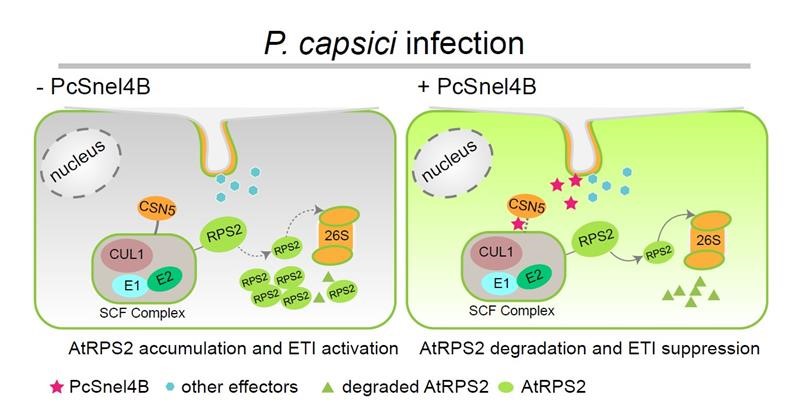On July 11th, 2023, the research group of crop Phytophthora effector function and utilization in the College of Plant Protection published an article entitled "Phytophthora RxLR effector PcSnel4B promotes degradation of resistance protein AtRPS2" online in the journal Plant Physiology. The first author of the paper is Dr. Gao Huhu, and Professor Liu XilI is the corresponding author.
Crop diseases caused by Phytophthora are serious threats to agricultural production. Typically, Phytophthora secretes various types of effector proteins to interfere with plant defense reactions during the pathogenic process, with RxLR effector proteins being the main type. But their functions have not been fully understood. Sne (suppressor of necrosis) proteins are a conserved type of RxLR effectors in Phytophthora. The group found in previous studies that Sne homolog protein (Sne-like) encoded by PcSnel4 in Phytophthora capsici was up-regulated during the early stage of P. capsici infection on tobacco, but its role and regulatory mechanism in the infection and pathogenesis remained unclear.
This study found that overexpression of two alleles of PcSnel4, PcSnel4A and PcSnel4B, both significantly promoted the infection. Using CRISPR/Cas9-mediated gene knockout technology to knockout the two alleles, there was no significant effect on the growth and development processes of P. capsici such as hyphal growth and sporulation, but the two alleles were essential effector proteins for the full virulence. PcSnel4B could inhibit cell death induced by AtRPS2, Avr3a/R3a, NIP, Bax and PsAvh241, but not cell death induced by INF1 and CRN4. Interaction protein screening and validation results showed that tobacco NbCSN5 was a target protein of PcSnel4A&4B. NbCSN5 was up-regulated during ETI occurrence, but down-regulated during the infection. Silencing NbCSN5 severely affected cell death induced by AtRPS2 and Avr3a/R3a. Further studies found that both PcSnel4B and NbCSN5 interacted with the core subunit NbCUL1 of the SCF complex, and PcSnel4B weakened the co-localization and interaction between NbCSN5 and NbCUL1 in plants. NbCSN5 negatively regulated the degradation of AtRPS2 protein by NbCUL1 and promoted cell death, while PcSnel4B inhibited the regulatory effect of NbCSN5 on NbCUL1 during the accumulation of AtRPS2 and cell death process, thereby inhibiting cell death induced by AtRPS2. This study has enriched the understanding of Phytophthora RxLR effector proteins regulating host plant immune mechanisms, providing theoretical support for further construction of disease-resistant materials.

The team members, including master students Guo Yuchen and Ren Mengyuan, doctoral students Shao Guangda, Gao Wenxin, and Tian Song, as well as young teachers, Associate Professor Peng Qin, Associate Researcher Gu Biao, and Associate Researcher Miao Jianqiang, also participated in the research work. The research work was supported by Shaanxi Provincial Innovation Capability Support Plan and the open subject of the National Key Laboratory of Crop Stress Biology in Dry Areas.
Original link: https://doi.org/10.1093/plphys/kiad404